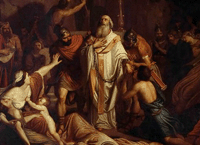
Early Christian Persecutions
The persecution of Christians in the first and second centuries (c. 30–200 AD) was mostly localized, sporadic, and socially driven, rather than systematic or empire-wide. Christians were a small, often misunderstood minority, and hostility against them grew as their distinct beliefs clashed with Roman religious and social norms.
I. First Century (c. 30–100 AD)
Context:
- Christianity began as a sect within Judaism.
- Christians were initially perceived by Romans as a Jewish subgroup, but gradually distinguished by their refusal to worship Roman gods or the emperor.
- There were no empire-wide laws targeting Christians yet.
Key Incidents:
1. Persecution in Jerusalem (c. 30s–60s AD)
- Christianity began as a sect within Judaism.
- By Jewish authorities: Early Christian leaders like Stephen (Acts 7) and James the Just were executed.
- The early church faced opposition primarily from religious leaders within Judaism.
2. Roman Persecution under Nero (64 AD)
- After the Great Fire of Rome, Emperor Nero blamed Christians to deflect suspicion.
- Christians were arrested, tortured, and executed (burned, crucified, thrown to beasts).
- Peter and Paul are traditionally believed to have been martyred during this time.
- ⚠️ This was the first official Roman persecution, but it was localized to Rome and not enforced elsewhere.
Nature and Causes of First-Century Persecution:
- Not based on formal legal status; more ad hoc.
- Christians were targeted for being "atheists" (rejecting Roman gods), superstitious, and socially disruptive.
- They met secretly, which aroused suspicion of criminal or immoral activity.
II. Second Century (c. 100–200 AD)
Growing Tension:
- Christianity spread across the empire, especially in urban centers.
- Christians became more visible and were seen as a threat to Roman unity and tradition.
- Refusal to worship the emperor or offer sacrifices was viewed as treasonous.
Key Incidents and Persecutions:
1. Pliny–Trajan Correspondence (c. 112 AD)
- Pliny the Younger, governor of Bithynia, asked Emperor Trajan how to handle Christians.
- Christians were not to be sought out, but if accused and unrepentant, they could be punished (including execution).
- Confirmed Christianity was not formally outlawed, but could be punished if brought to official attention.
2. Martyrdom of Ignatius of Antioch (c. 107 AD)
- A bishop who was arrested and taken to Rome, where he was executed.
- Wrote letters encouraging Christians to remain faithful and embrace martyrdom.
3. Martyrdom of Polycarp (c. 155 AD)
- Bishop of Smyrna, burned alive after refusing to renounce Christ.
- His death became a model of Christian martyrdom and steadfast faith.
4. Persecution under Marcus Aurelius (c. 161–180 AD)
- Not centrally ordered, but local hostility increased.
- Notable martyrdoms: Justin Martyr (philosopher-apologist), Christians in Lyon and Vienne (177 AD) tortured and executed.
Nature and Causes of Second-Century Persecution:
Local and reactive, not empire-wide or continuous.
Driven by-
- Popular hostility, rumors (e.g., cannibalism, incest, atheism).
- Christians’ refusal to participate in civic religion (seen as impiety).
- Periodic scapegoating during crises (e.g., plagues, disasters).
Legal ambiguity: Christians could be prosecuted simply for bearing the name "Christian" if brought before authorities.

